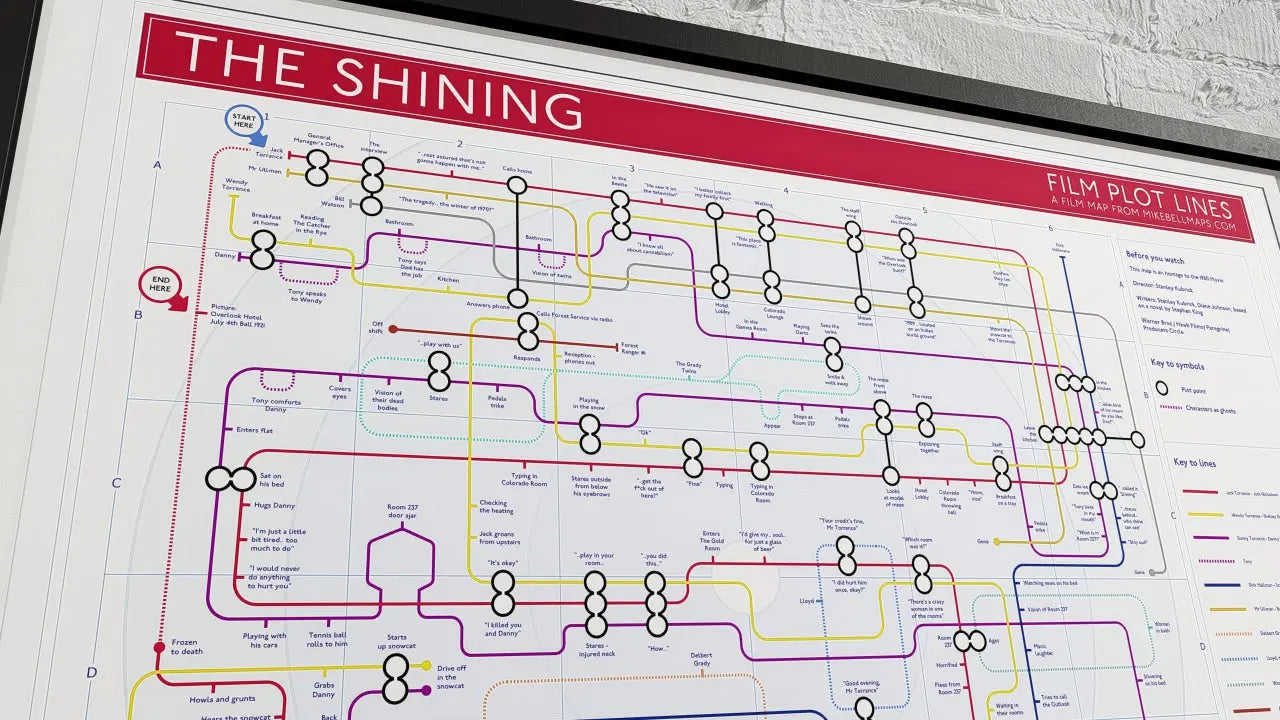Few horror stories have inspired as much debate as The Shining. On one side, Stephen King’s 1977 novel—a chilling tale of family, trauma, and addiction. On the other, Stanley Kubrick’s 1980 film adaptation—a surreal descent into madness and isolation. Both are classics, yet they diverge sharply in character, tone, and meaning. Let’s break down how they compare with my plot lines tube map as a guide to the movie story..
The Story Behind The Shining
At the heart of both versions is the Torrance family: Jack, the frustrated writer and recovering alcoholic; Wendy, his supportive but vulnerable wife; and Danny, their son with psychic powers known as the shining.
They move into the remote Overlook Hotel as winter caretakers. Snow isolates them, and the hotel’s dark presence pushes Jack toward violence while Danny and Wendy struggle to survive.
The skeleton of the story remains the same, but how it’s told makes all the difference between King’s book and Kubrick’s film.
Jack Torrance: Flawed Man vs. Madman
In King’s novel, Jack is sympathetic despite his flaws. He’s a man wrestling with addiction, guilt, and the fear of becoming his abusive father. The hotel exploits these weaknesses, dragging him into darkness. His downfall is tragic, not inevitable.
In Kubrick’s film, Jack Nicholson plays him as unhinged from the start. His sarcasm and manic energy suggest violence simmering beneath the surface. Instead of a man corrupted, he’s a man revealed—making the film less about tragedy and more about madness.
Wendy Torrance: Survivor or Victim?
King’s Wendy is strong, resourceful, and protective of Danny. She challenges Jack and nearly leaves the hotel when danger rises.
Kubrick’s Wendy, by contrast, is portrayed as anxious and fragile. Shelley Duvall’s performance amplifies her vulnerability, which heightens the horror but reduces her agency. She still saves Danny, but the balance between fear and strength shifts dramatically.
Danny and the Shining
King’s Danny uses his psychic gift to sense the Overlook’s history, communicate with Hallorann, and resist the hotel. He’s a central player in the fight.
Kubrick’s Danny is more of a witness. His visions—the blood elevator, the twin girls—are chilling but symbolic. His shining is atmospheric, not a weapon.
The Overlook Hotel: Haunted House vs. Psychological Prison
In the novel, the Overlook is alive. Its violent history of gangsters, suicides, and occult practices surfaces directly, and it manipulates Jack with deliberate intent.
In the film, the Overlook is ambiguous. Its impossible hallways and cavernous spaces create unease. Are the ghosts real? Or are they hallucinations? The final photograph of Jack at a 1921 party leaves the audience questioning whether he’s been absorbed into the hotel’s eternal cycle.
Different Endings
King’s novel ends with Jack briefly regaining clarity, warning Danny before dying as the hotel’s boiler explodes, destroying the Overlook. Hallorann survives and helps Wendy and Danny escape.
Kubrick’s film is bleaker. Jack freezes to death in the hedge maze after losing Danny. There’s no redemption, no explosion, and the hotel remains untouched—an eternal enigma.
Why King Disliked Kubrick’s Film
Stephen King has long criticized Kubrick’s adaptation. He felt the film stripped away the emotional core, especially Jack’s redemption arc and Wendy’s strength. To him, Kubrick’s Jack was “crazy from the first scene,” making the story less tragic and more cynical.
Kubrick, however, crafted a colder, surreal film that thrives on ambiguity. His vision is less about possession and more about inevitability.
Which Version Lasts Longer in the Mind?
-
The novel offers warmth, tragedy, and emotional depth, focusing on addiction, family, and trauma.
-
The film delivers icy dread and unforgettable imagery, creating a labyrinth of ambiguity that haunts viewers decades later.
Together, they represent two sides of horror storytelling: one emotional, one psychological.
Frequently Asked Questions About The Shining
What is the main difference between The Shining book and movie?
Stephen King’s novel portrays Jack Torrance as a flawed man tragically corrupted by the Overlook Hotel, while Stanley Kubrick’s film presents him as unstable from the start, descending inevitably into madness. The novel emphasizes redemption and family trauma, while the movie highlights psychological terror and ambiguity.
Why did Stephen King dislike Stanley Kubrick’s The Shining?
King felt Kubrick stripped away the emotional heart of the story. He criticized Jack Nicholson’s portrayal of Jack as “crazy from the first scene” and disliked the weaker depiction of Wendy. For King, the film lost the themes of addiction, abuse, and redemption that anchored the novel.
How does The Shining novel end compared to the movie?
In the novel, Jack briefly regains control and warns Danny before dying when the Overlook’s boiler explodes, destroying the hotel. In the movie, Jack chases Danny into the hedge maze, gets lost, and freezes to death. Kubrick leaves the Overlook intact, with the chilling photograph implying Jack has joined its eternal cycle.
Is the Overlook Hotel haunted in both versions?
In King’s book, the Overlook is explicitly a malevolent force with a violent history, manipulating Jack to claim Danny’s psychic power. In Kubrick’s film, the hotel is more ambiguous—it could be haunted, or Jack’s visions could be hallucinations. This ambiguity is part of what makes the film so unsettling.
What role does Danny’s “shining” play in the story?
In the novel, Danny’s psychic gift is central—he senses the Overlook’s evil, resists its influence, and telepathically calls Hallorann for help. In the film, Danny’s shining is presented more through iconic imagery—such as the blood-filled elevator and the twin girls—serving to unsettle the audience rather than actively combat the hotel.
Related Film Maps
Explore my artwork inspired by iconic films:
-
The Shining Film Map – visualizing Kubrick’s masterpiece in a unique design.James Bond Film Chronology Map – every Bond adventure in order, mapped out.Blade Runner Map – charting the futuristic noir of Ridley Scott’s classic.
These pieces bring cinematic legacies to life in the same way my music maps capture bands’ histories.






